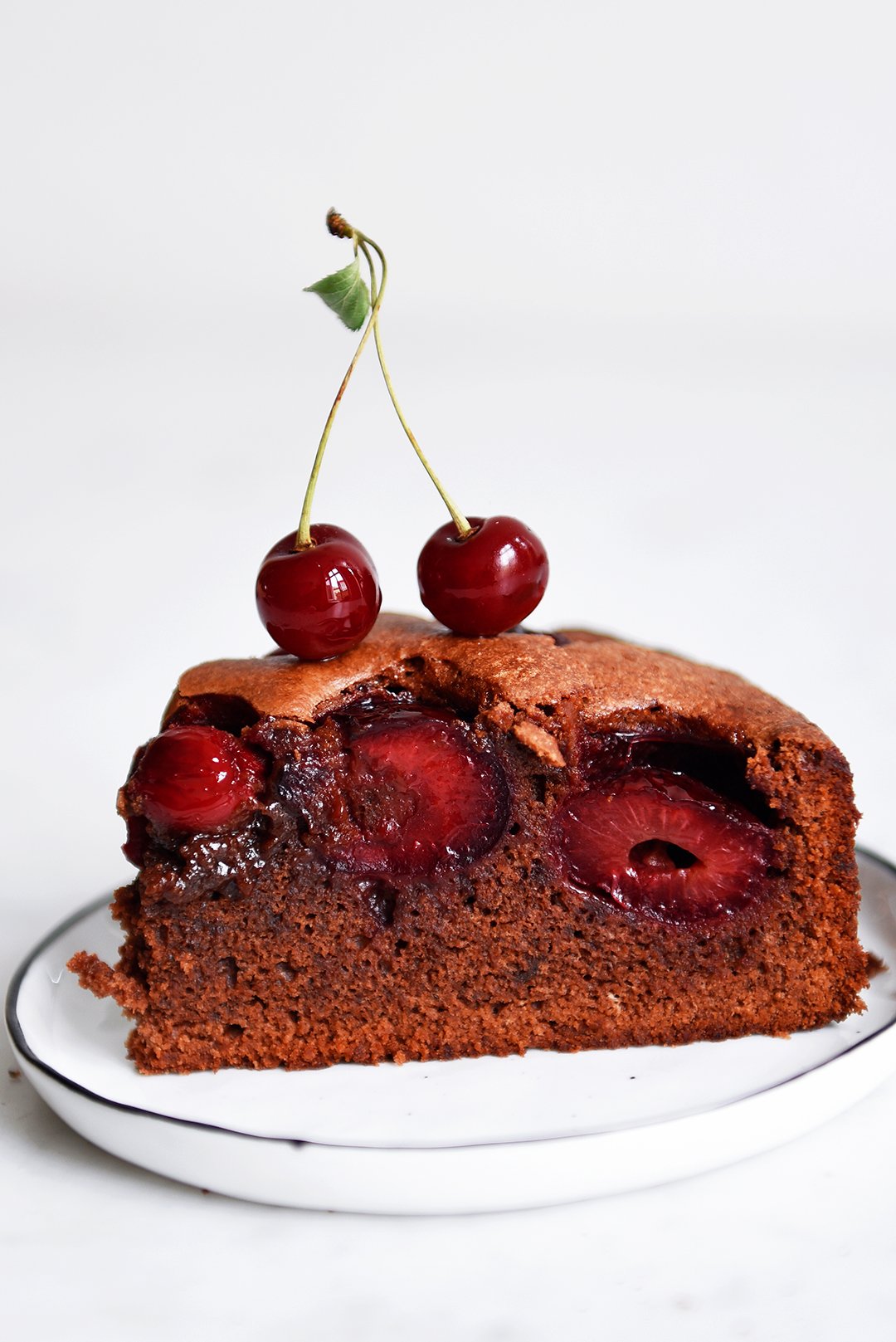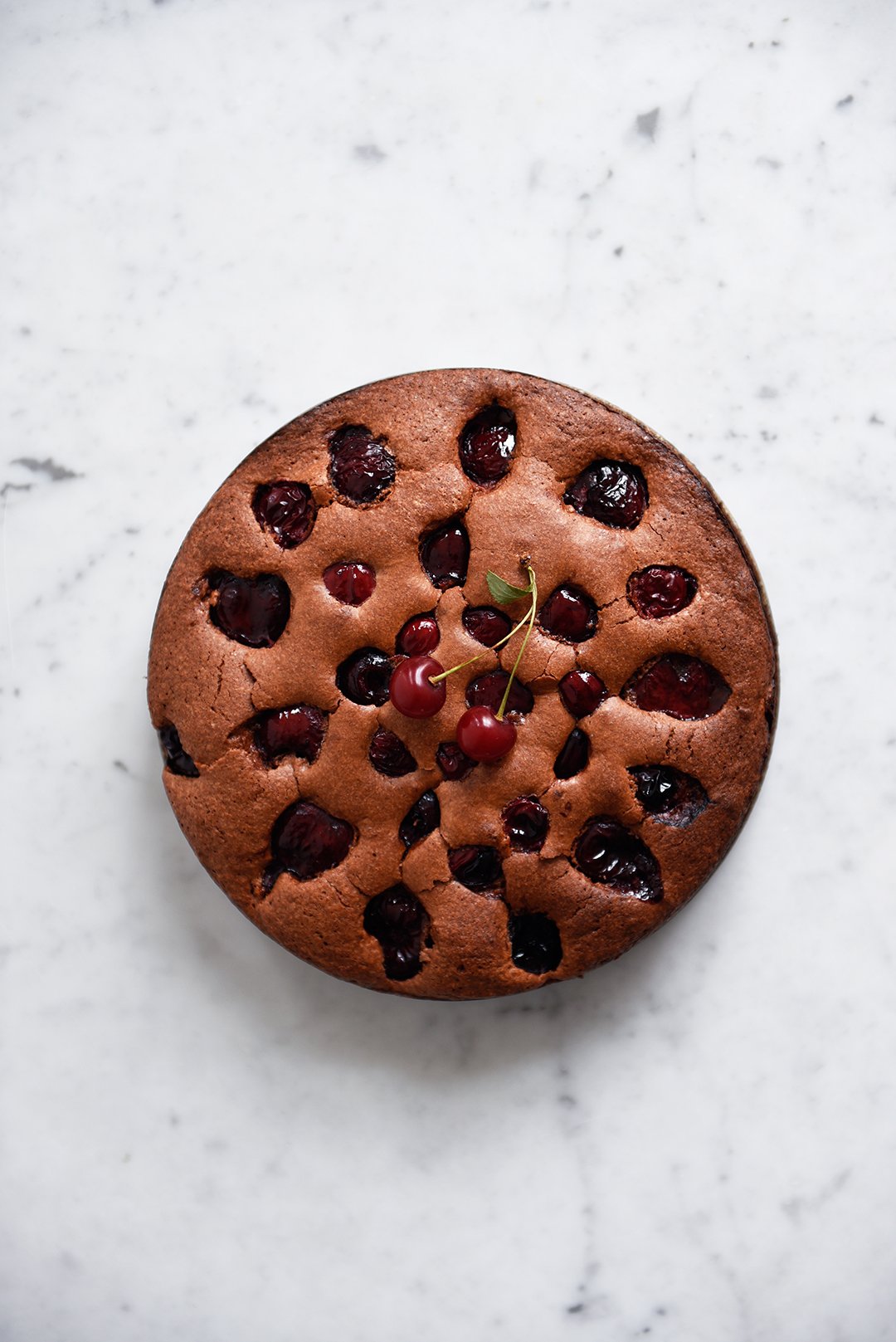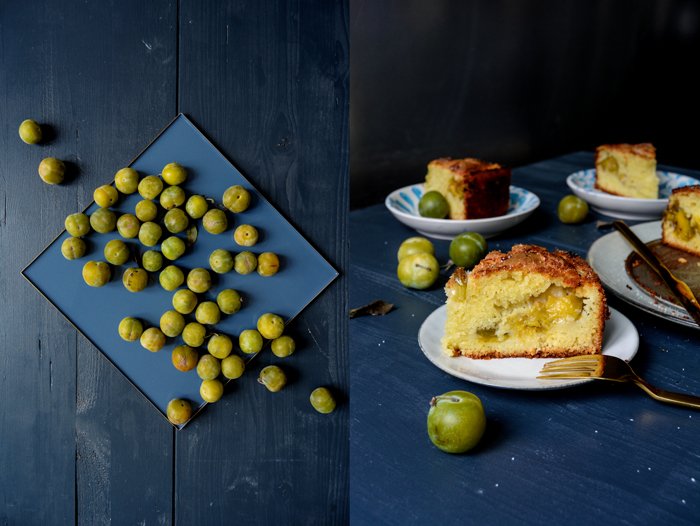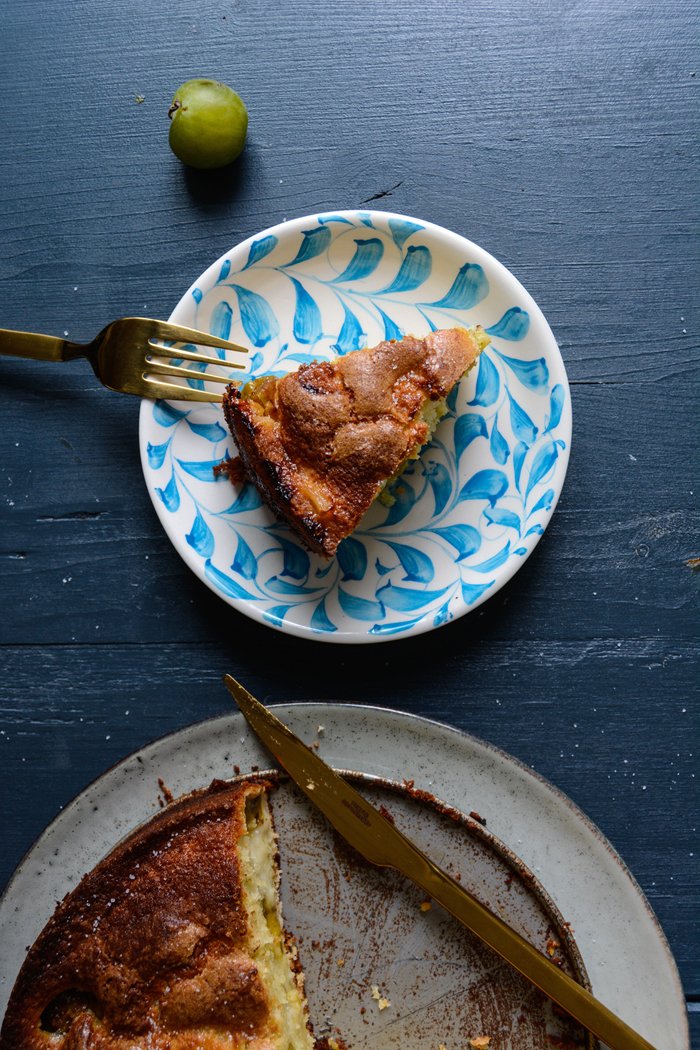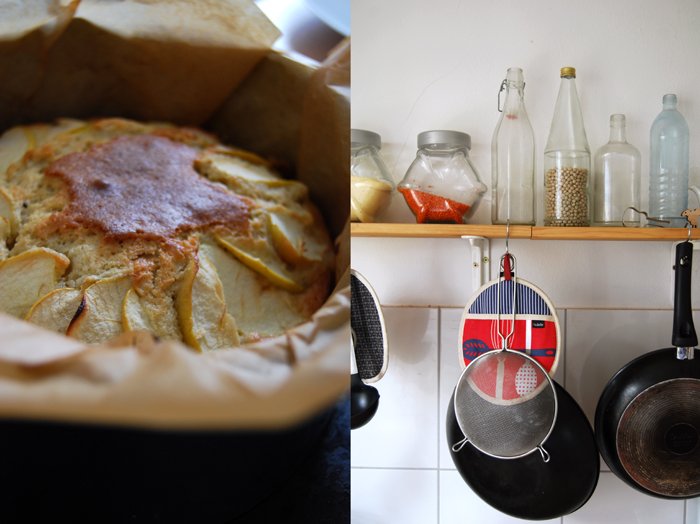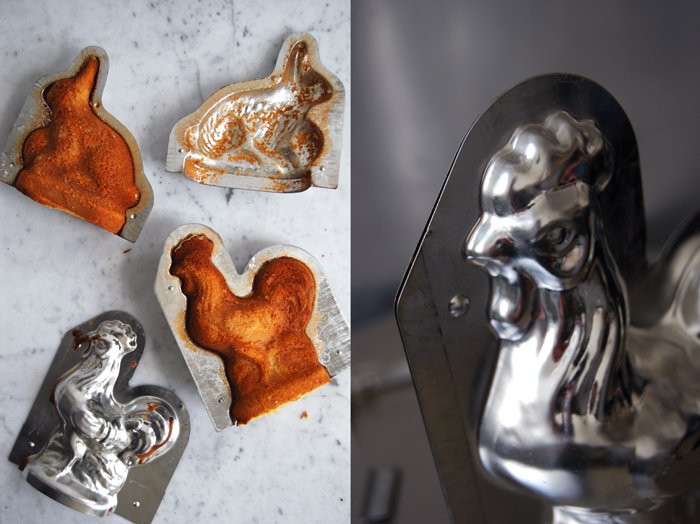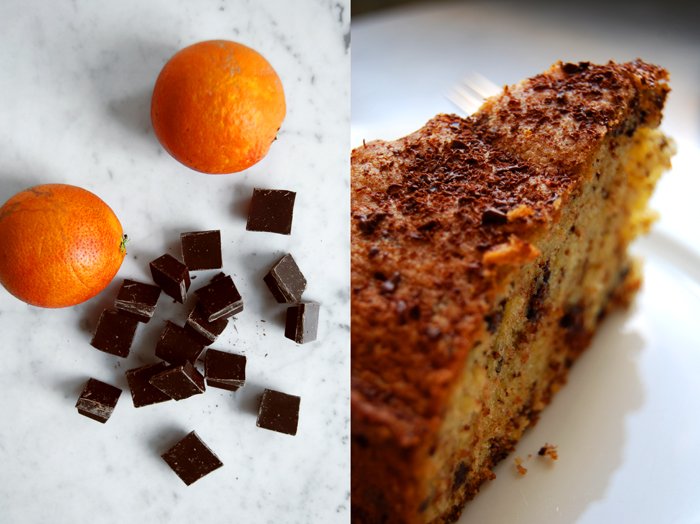Cherry Chocolate Cake
I desperately craved chocolate and cherries - sometimes it's so easy to come up with a new recipe! I used my favorite chocolate cake recipe from my 365 book - recipe no. 189 crowned by a marbled raspberry whipped cream - and topped it off with Turkish sweet cherries and German sour cherries. The cake is made with melted bittersweet chocolate, which I much prefer over cakes made with cocoa powder and water. I find the taste more complex when using proper chocolate. The egg whites are beaten stiff, which gives the cake enough oomph to rise. However, I wasn't sure if the cherries would be too heavy and drag it down so I added a little baking powder. I decreased the amount of sugar to balance the fruit's natural sweetness and was more than pleased with the result. It's a very comforting cake, hassle-free and easy to love.
As I watched the humming mixer slowly swirl the melted chocolate into the batter, I noticed a pattern. Every time July rolls around, I develop a new cherry-chocolate recipe. It's not really a surprise, the fruit's sweet juices and the depth of bittersweet chocolate is a genius combination. Yet seeing it become - unintentionally - a blog tradition struck me. There's a Cherry Chocolate Meringue Pie in the archives, recipes for Black Forest Pancakes, Cherry Chocolate Marble Bundt Cake and a Cherry Chocolate Tart. All posted in July and August. And every year I ask myself "is this combination summery enough? Is this what you really want to nibble on on a hot afternoon?." The answer is a resounding yes! and the reason is just as simple: our mind tells us exactly what we need. When we crave a certain ingredient or combination and when we notice this craving, it's usually the best thing you can possibly put into your mouth. A chocolate and cherry cake answers the pleading cravings of every chocolate and summer fruit lover and is just as perfect for breakfast and brunch as for afternoon tea or dessert after dinner.
Cherry Chocolate Cake
140g / 5 ounces bittersweet chocolate
150g / 2/3 cup unsalted butter
1/4 teaspoon ground cinnamon
1/4 teaspoon ground cardamom
4 large eggs, separated
1/8 tsp fine sea salt
150g / 3/4 cup granulated sugar
130g / 1 cup all-purpose flour (or white spelt flour type 630)
1/4 teaspoon baking powder
140g / 5 ounces pitted sweet cherries (weight without pits!)
60g / 2 ounces pitted sour cherries (weight without pits!)
Preheat the oven to 180°C / 350°F (preferably convection setting). Butter an 20 cm / 8-inch springform pan.
For the cake, melt the chocolate, butter, cinnamon, and cardamom in a small saucepan over low heat, whisking until smooth; let cool for a few minutes.
In the bowl of a stand mixer fitted with the whisk attachment, whisk the egg whites and salt for a few minutes or until stiff, transfer to a large bowl, and set aside.
In the same bowl of the stand mixer fitted with the whisk attachment, whisk the egg yolks and sugar for 2 minutes or until thick and creamy. Add the chocolate mixture and mix for 1 minute or until well combined. Combine the flour and baking powder, add to the butter-chocolate mixture, and mix until well combined then fold the egg whites into the batter (it will be a bit sticky and takes some time, be patient). Spread the batter evenly in the prepared pan and arrange the cherries on top, pushing them just a little into the batter (see picture below). Bake for about 45 minutes (slightly longer if using a conventional oven) or until golden brown and spongy. If you insert a skewer in the center of the cake, it should come out almost clean. Let the cake cool for 10 minutes then take it out of the pan.
French Yogurt Cake with Greengage Plums for a late summer Sunday
Piles of plums, peaches, and apricots fill my kitchen's countertops. Plates with tiny yellow mirabelles and slightly larger greengage plums make it look and smell like a farmers' market - the fruit flies are having a feast. Every season has its culinary highlights, but late summer is the most lavish time of the year. Figs and berries are at their peak, packed with sweet juices. The whole variety of stone fruits is ready to be picked from the trees, and early apples tease me with their sour quality, which is so perfect for baked treats. Sponge cakes, muffins, tarts, and pies are just waiting to be paired with one of these summer fruits - who needs whipped cream or butter cream frosting? Now is the time to stir some fruit into the dough and enjoy one of the best sweet combinations ever: cake and fruit.
Sunday is my favourite day to bake cake. I start the oven right after breakfast, which tends to end rather late. Not so much because I sleep in, it's more because I enjoy the luxury of not having to rush after a busy week. I take my time, lots of time.
Looking at the long tradition of baking in my life, there are two recipes that I use far more often than others, not only on Sundays. The first one is my fluffy German waffle recipe, it's a family weekend ritual, and the other one is a simple fruit cake. It may sound quite simple but there are a million possible variations of this treat: you can add white chocolate, cornstarch for a lighter texture, or put some crumble on top. Olive oil creates a warm flavour and a juicy texture, great for a cake but also for my fig and ricotta muffins.
Today I went for a classic French yogurt cake, which is usually enjoyed plain. However, my enthusiasm for fruit led to a juicy filling of greengage plums. They were supposed to become a topping, but gravity, in combination with a light sponge dough, had different plans and the fruit sunk. The dairy product is mixed with mild olive oil, no butter, and adds a subtle sour hint. The yellow-green plums make it sweet and fruity (red plums would work here as well), it's just right for my late summer Sunday.
French Yogurt Cake with Greengage Plums
Makes a 20cm / 8" cake
plain flour 230g / 1 3/4 cups
baking powder 2 1/2 teaspoons
fine sea salt 1/4 teaspoon
plain yogurt 155g / 2/3 cup
mild olive oil 155ml / 2/3 cup
organic eggs 3, lightly beaten
granulated sugar 200g / 1 cup, plus 2 teaspoons for the topping
zest of 1 medium lemon
greengage (or red plums), cut on 1 side and pitted, 500g / 18 ounces
Preheat the oven to 180°C / 350°F (preferably convection setting). Butter a 20cm / 8" springform pan.
In a large bowl, whisk together the flour, baking powder, and salt.
Add the yogurt, olive oil, eggs, sugar, and lemon zest and mix with an electric mixer on low speed for about 1 minute, just until there's no trace of flour left and the dough is combined. Pour the batter into the prepared pan and arrange the greengage on top of the batter (vertically, see picture above). Sprinkle with the remaining 2 teaspoons of sugar and bake for about 60 minutes (slightly longer if using a conventional oven) or until golden brown on top. If you insert a skewer in the center of the cake, it should come out almost clean. Let the cake cool in the pan for a few minutes before serving.
meet in your kitchen | Phia & Josh bake Mum's French Cake
This is the start of a new series of features on the blog - meet in your kitchen! I will be meeting artists, chefs - people with a great passion for what they do, in their kitchen, to cook or to bake while we talk about their culinary life, current projects and inspiration.
I'm very excited to start with two artists who I first saw live a couple years ago, Phia and Josh! Phia performed on a houseboat on a big lake outside Berlin and mesmerized me with her singing, her Kalimba and the loops she created during her show.
The two artists grew up in Melbourne and decided to move to Berlin three years ago to grow as artists and touch new musical ground. They soon found that their ideas worked well together and the time was ripe for a colaboration. Phia, the singer who plays the kalimba and Josh, the guitarist and producer understand and enhance each other and in a few months they will share their musical vision on the first Phia album!
Although the two are very busy in the studio at the moment they took some time out and invited me to their Berlin kitchen. They arrived in the city with little more than a suitcase and had to piece together everything from scratch. The furniture and every single pot, plate and mug has its own story, mostly coming from friends who moved back home or flea markets, a unique space full of soul and personal memories.
Phia's family is very passionate about cooking, both her parents love to be creative in the kitchen. She chose to share a very special recipe with me that she used to bake with her mother when she was a child, a recipe rich in young kitchen memories! It's Mum's French Cake, a spongy and fruity cake which is as delicious as it is quick and easy to bake, a perfect candidate for those spontaneous late night (or early morning) baking sessions! Phia covered the cake with apples, but plums are another of her favourites for this recipe.
Mum's French Cake
"I chose a really simple cake recipe that my mum taught me. I’m not the most confident baker but this one is so simple. Depending on how large you want the cake, you take 1-3 eggs and weigh them, then put in the same weight of flour, melted butter and sugar. Then choose whatever fruit you want to put on top. My mum actually brought the recipe home from a French class she was in when I was younger. So the first time we made it we did it in French: “… deus oeufs ...” etc!"
For an 18cm / 7" springform pan you need
apple, quartered and thinly sliced, 1
organic eggs 2
weigh the eggs with their shells and measure the same weight of the following 3 ingredients:
plain flour
butter, melted
granulated sugar
plus
baking powder 1 tablespoon
a pinch of salt
Set the oven to 180°C / 355°F and butter the springform pan.
Combine the dry ingredients. Mix the eggs and butter for a few minutes till fluffy and add the dry mixture, mix until well combined. Pour the dough into the springform pan, arrange the apples in circles and bake for 25 minutes or until golden. Check with a skewer, it should come out clean. Serve warm!
You both grew up in Australia, what are your food memories?
Josh: Australia is a fairly wealthy country with really good weather and at various times a great influx of immigrants from around the world (although not currently because of our extreme rightwing government). This has meant that food is in wide variety and really great quality. You could find Indian, Afghan, Vietnamese, Italian, Greek, Chinese, Turkish, Thai, African, Lebanese, Japanese and a lot more (as well as modern fusion) to a beautiful standard all within close proximity. Restaurants just don’t survive if they’re not doing it the way it’s done in the home country. I guess we’re spoilt in a culinary way. This standard or commitment to food is still lagging very much in Germany which I find surprising because there are a lot of people from around the world living there. I’m not saying it doesn’t exist but I still have not found a decent curry.
What effect did the move to Berlin have on your cooking?
Phia: I’ve become a lot more confident since moving here! Last year I became really bored with the recipes that I knew, so I bought a couple of cookbooks and made some new meals. My favourite was Yotam Ottolenghi’s “Plenty”, a vegetarian cookbook. He has this delicious soup made with chickpeas based on a Tuscan ribollita which I make a lot now.
What was the first dish you cooked on your own, what is your first cooking memory?
Josh: I started lifting weights after high school, trying to get buff. At the time I was known as “Mr. Vegetarian” because I was pretty big but still vegetarian. My memory of cooking by myself (that wasn’t frozen dim sims or pizza) was a taco filling that was packed with kidney beans and chickpeas for protein.
What are your favourite places to buy and enjoy food in Berlin?
Phia:We are really spoiled for choice in our part of Neukölln. All of these are within walking distance of us:Favourite coffee: Five Elephant, a super nice place in ReichenbergerstrasseDelicious and cheap tapas: Gaston on WeserstrasseBest gelati: Fräulein Frost on PanierstrasseFresh fruit and veggies: the turkish market on Maybachufer
Josh: Everything Sophia has said plus ‘Il Casolare’ - excellent pizza and atmosphere by the canal.
You live and work in Berlin at the moment, what are your upcoming projects?
Josh: The Phia album is still in full swing, still producing… we’ve mixed some of the tracks and still going over the editing and post-production stuff for quite a few of them. Final mixing should happen at the end of August.
I’ve been producing some music for a few other artists too.
I’m also working on my own project ‘Josh The Cat’. I sing songs, tell stories, dance a little bit with my guitar. Influenced by Bowie, TuneYards and Radiohead but people say it’s sounds a bit like The Whitest Boy Alive with a loop pedal and I look like the guitarist from Incubus. I recently heard The Whitest Boy Alive have disbanded so maybe there is an opening for me.
What or who inspired you to become musicians?
Phia:I grew up in a household filled with music. My mum and my sister and I used to sing three part harmonies, I learnt piano, sung in lots of choirs and did musicals. It never occurred to me that I could be a professional musician though. At school I thought I would be a teacher, or a writer. After high school I made a spontaneous decision to enter a music university rather than the law degree I had been accepted into. I thought I’d complete a year and then go back to academia, but I stayed!
Why did you choose Berlin as the place to live and work?
Josh: I wanted to shake up my life a little. I’d played in a few different bands in Melbourne ranging from Synthpop, FreeJazz to Instrumental soundscape. It was either NYC, Tokyo or Berlin and Berlin won. It’s a great base for branching out, there’s a lot of creatives to bounce off and I find the East meets West, the old crashing into the new, inspiring.
You just finished recording your album, what were your biggest influences during the writing and recording process?
Phia: The songs on the record definitely reflect the period of change of moving from Melbourne to Berlin. Some were written just before the move, and some after, and I think you can hear a continuous thread throughout the album of conflicted feelings change brings. The joy of expanding our experiences to the pull of homesickness.
Our lifestyle has been so different since moving to Berlin. The people we’ve met, the places we’ve toured, even just day-to-day living in Neukölln and having the luxury of working on music. You can definitely hear that on the album.
What did you choose to share on eat in my kitchen and why?
Phia:I chose a really simple cake recipe that my mum taught me. I’m not the most confident baker but this one is so simple. Depending on how large you want the cake, you take 1-3 eggs and weigh them, then put in the same weight of flour, melted butter and sugar. Then choose whatever fruit you want to put on top. My mum actually brought the recipe home from a French class she was in when I was younger. So the first time we made it we did it in French: “… deus oeufs ...” etc!
If you could choose one person to cook a meal for you, who and what would it be?
Phia: Merril Garbus from Tune-yards. I bet she’d have some killer recipes.
Josh: The RZA from Wu-Tang Clan comes to mind. It would be good to have a chat with him too.
You're going to have ten friends over for a spontaneous dinner, what will be on the table?
Phia:Definitely a big salad, maybe with orange and chickpeas, lots of wine, maybe some roast veggies or a baked dish.
Josh: Depends what is in the house. I find lentil soup very satisfying and hopefully the guests would too.
What was your childhood's culinary favourite and what is it now?
Phia: I wasn’t the most adventurous eater as a child so it was probably that Australian staple borrowed from our Italian immigrants - spaghetti bolognaise. Now I love eating new foods from the countries we go on tour. Last year I tried perogi in Poland for the first time, which was amazing.
Josh: My favorite food is Indian or Sri Lankan, I love the spices they use and the vivid flavours. Although I’m not vegetarian I prefer vegetarian food and this goes well for me with all the lentils, vegetables, chickpeas and the occasional paneer their food has. I don’t remember particularly liking food as a very young child but I guess I’ve liked any food from Asia since about the age of 12 or 13. I’ve always hated asparagus and it still makes me gag.
Do you prefer to cook on your own or together with others?
Phia: When I wasn’t so confident I needed to do it on my own, I didn’t like being watched! But now I love learning from others and it is fun to cook together.
Josh: I think someone who is good with food generally needs patience or at the very least a sensibility for how all the elements interact. I don’t really have that. Or perhaps my problem is that I usually try to ignore I’m hungry until I am absolutely ravenous and by that point I have no patience for preparing things properly. So cooking for myself comes out of necessity and cooking with others is probably more fun because it has probably been planned ahead. By others, I mean Sophia, who has good ideas generally, plans ahead and never allows herself to get so hungry as to become irrational and hasty as I do.
Which meals do you prefer, improvised or planned?
Phia: I’m definitely a meal planner - no improvising in the kitchen for me!
Josh: I would admit that conceptually a planned meal should work out the best but I haven’t properly tried that.
Which meal would you never cook again?
Josh: When I was at university I was known by my housemates for my signature dish: “bachelor’s special” which ingredients consisted of pretty much everything cooked in a saucepan served over some sort of carbohydrate. I think I’ll leave that one in the past.
Thank you Phia and Josh!
Here you can listen to Phia and Josh's music and find out when the album will be released: www.listentophia.com
Frankfurter Kranz, a German Buttercream Cake with caramelized Hazelnuts
The Frankfurt Crown Cake, also known as Frankfurter Kranz is the queen of German buttercream cakes and my grandmother was a master at baking it. There was no special occasion, no family Sunday lunch without this opulent cake on the table. If you're on a diet you should avoid it because as all buttercream cakes, it needs lots of eggs, sugar and butter to transform into a delicious layered sponge cake filled and covered with German vanilla buttercream and sprinkled with caramelised hazelnuts. My Granny's lunches used to start with a green salad with a sugared cream dressing followed by the best beef rouladen (beef olive) filled with prosciutto, gherkin and mustard. While everyone else was worried about how one would manage to eat her traditional Frankfurt Crown Cake so soon at tea time, I was already excited and looking forward to eating my beloved buttercream cake.
The outside of the spongy cake, made with lots of vanilla and eggs, soaks a bit of the cream, which is made of vanilla pudding mixed with butter, that's why the cake is best after 2 days. The aromas have to spread, the vanilla and also the buttery caramelized hazelnuts infuse the cake. It's best to keep it in the fridge but it should always be eaten at room temperature. I didn't manage to wait for a couple days, the cake looked so good, I had to eat it as soon as I sprinkled the last hazelnuts on top. It was great but when I ate a piece on the 3rd day, I was reminded why it's good to be patient. The cake was amazing, it had developed its full deep taste and I understood why this cake was my Granny's famous signature cake.
Sometimes life is just about enjoying a piece of cake, no matter how much butter or eggs were needed to make it. Mother's and grandmother's know that!
Happy Mother's Day!
Frankfurt Crown Cake, Frankfurter Kranz
For a 23cm / 9″ bundt pan you need
For the sponge cake
butter, at room temperature, 200g / 7 ounces
granulated sugar 225g / 8 ounces
a pinch of fresh vanilla
organic eggs 6
plain flour, sieved, 200g / 7 ounces
cornstarch, 100g / 3.5 ounces
baking powder 3 teaspoons
a pinch of salt
dry breadcrumbs to sprinkle the bundt pan
Set the oven to 180°C / 355°F top/ bottom heat. Butter a bundt pan and sprinkle with bread crumbs.
Beat the butter, sugar and vanilla till fluffy, add the eggs, one at a time and continue beating for a few minutes till thick, creamy and light yellow. Combine the dry ingredients and fold gently into the butter egg mixture with a wooden spoon (in batches, combine well in between). Scrape the dough into the bundt pan and bake for 45 minutes or until golden. Check with a skewer, it should come out clean. Let the cake cool for 2-3 minutes before you turn it over onto a wire rack to cool completely. When the cake has cooled off completely, slice it 3 times into 4 layers.
For the buttercream
All ingredients for the buttercream must be at the same temperature (room temperature) to combine well!
butter 250g / 9 ounces
organic egg yolks 4
cornstarch 60g / 2 ounces
granulated sugar 120g / 4.5 ounces
milk 500ml / 17 ounces
a pinch of salt
vanilla bean, slit slightly, 1
Beat the butter for 10 minutes till white and fluffy.
Whisk the egg yolks with the cornstarch, sugar, salt and 50ml / 2 ounces of the milk till well combined.
In a sauce pan, bring the remaining milk together with the vanilla bean to a boil. Take the vanilla bean out, scrape the seeds out of the bean into the milk. Add the egg mixture to the hot milk, whisking well. Take the sauce pan off the heat after 1 minute and continue whisking for 2 minutes till stiff. Fill into a bowl and cover the pudding's surface with cling film.
When the vanilla pudding has cooled off completely, press it through a sieve and mix in batches with the beaten butter, first with a spoon and then with your mixer for a few seconds till nice and creamy.
For the caramelized hazelnuts
hazelnuts, finely chopped, 200g / 7 ounces
granulated sugar 100g / 3.5 ounces
butter 35g / 1.5 ounces
In a large heavy pan, heat up the hazelnuts, sugar and butter on high-medium temperature and roast for around 5 minutes till golden brown and caramelized, stirring constantly. Take off the heat and spread on parchment paper.
Assembling the Frankfurter Kranz
Leave around 1/3 of the buttercream to cover the Frankfurter Kranz and spread the remaining cream on the 3 layers of cake. Start with the bottom one, spread with cream, cover with the next layer of cake and continue with the other layers. When the cake is assembled, spread the remaining cream gently all over the cake and sprinkle with the caramelized nuts on all sides, inside and out.
You can eat the cake right away or be patient and keep it in the fridge for 1-2 days before you serve it.
Eggnog Sponge Cake with Whipped Cream
Eggnog has a bit of an old fashioned reputation but let someone try a sip, even rather doubtful gourmets, and you will see a hint of appreciation on their faces.
It used to be a popular drink in bars, both of my grandmothers used to love it and even made their own in their kitchens. This was once a true party classic, in the 1950s and 60s! Today, people pour it over their ice cream or cake like my mother who always keeps a little bottle of it in her fridge for this reason. Some make it at home for Christmas but it feels like it lost its popularity. I find this unfortunate, I have quite a soft spot for it - eggnog is creamy, smooth, sweet and eggy. I like to drink it sometimes, as a digestif, preferably out of tiny old fashioned glasses with a short stem - 50s style to make the experience complete.
I believe that something that was so passionately enjoyed a few decades ago - and that tastes so good - is reason enough to be included in my today’s kitchen activities. I'm up for an easy Easter cake, a spongy cake made with lots of eggnog. A few days ago my aunt Ursula gave me two 3d-cake pans and wrote down one of her recipes for a juicy cake laced with the yellow liqueur that her own mother used to like so much. I doubled the recipe and baked it in lovely rabbit and chicken molds (but you can use a 20cm / 8″ cake pan).
I prepared some whipped cream with even more eggnog while the cakes were in the oven and noticed at one point that the cakes started to overflow. Luckily, my miscalculation didn't do the final cake any harm. It rose and dropped off the molds like a volcano and continued to bake on the tray but turned out as spongy and juicy as the cake in the molds.
This is a quick cake. After only 30 minutes in the oven, I was rewarded with a delicious eggnog-y teatime treat, best dipped into eggnog whipped cream and enjoyed with an extra shot of this special liqueur from the past, in an old fashioned glass of course. Cheers to our grandmothers!
Eggnog Sponge Cake with Whipped Cream
For a 20cm / 8″ cake pan you need
organic eggs 4
granulated sugar 140g / 3/4 cup
a pinch of fresh vanilla (scraped out of a vanilla pod)
vegetable oil (I use sunflower oil) 140ml / 2/3 cup
eggnog 140ml / 2/3 cup plus one shot for the whipped cream
plain flour 220g / 1 2/3 cups
baking powder 2 teaspoons
a pinch of salt
heavy cream 200ml / 3/4 cup plus 1 tablespoon
Set the oven to 170°C / 340°F (preferably convection setting) and butter the cake pan.
Beat the eggs together with the sugar and vanilla until fluffy. Slowly, add the oil and and eggnog and continue mixing. Combine the flour, salt and baking powder and mix quickly into the liquid mixture. Scrape the batter into the prepared pan and bake for 40 minutes or until golden brown. Check with a skewer, it should come out clean. In the 2 figure molds, the cake needed just 30 minutes. Let the cake cool for 5 minutes.
Whip the cream, stir in a shot of eggnog and serve with the cake.
Bittersweet Chocolate and Orange Sponge Cake
Last week I wrote about one of my numerous phone calls with my Maltese granny who is actually my boyfriend's granny but over the years, after so many stays on her home island and through our shared passion for food she "adopted" me. That's how it feels, she became my granny. In our last conversation she gave me a wonderful recipe for the Maltese tea time cookies with vermouth and she also mentioned a cake made with bittersweet chocolate and orange (juice and zest). I love this combination but my boyfriend isn't so fond of it and I didn't want to end up eating a whole cake on my own. But she insisted on giving it a try, she knows her grandson after all, and she was right!
We both agreed that this cake is amazing, simple but so aromatic. The texture is very spongy and on top it has a fine sugary crust, a bit flaky. I sprinkled it with some more chocolate when the top was still a bit warm and it melted into the crust. Granny Edith was right, I didn't have to eat the cake on my own and it didn't even last for 2 days!
Bittersweet Chocolate and Orange Sponge Cake
For a 20cm / 8″ cake pan you need
butter 180g / 6.5 ounces
granulated sugar 210g / 7.5 ounces
plain flour 180g / 6.5 ounces
baking powder 2 teaspoons
a pinch of salt
organic eggs 3
orange juice 2 tablespoons
orange zest 1 1/2 tablespoons
bittersweet chocolate, chopped coarsely, 100g / 3.5 ounces plus 1 tablespoon finely grated for the topping
Set the oven to 175°C / 350°F (fan-assisted oven) and butter the cake pan.
Mix the butter with the sugar and orange zest till fluffy. Add the eggs, one at a time and mix well for a couple minutes. Add the flour, baking powder, salt and orange juice and mix quickly until everything is combined. Stir in the chopped chocolate and scrape the dough into the prepared pan. Bake for 40 minutes or until golden brown. Check with a skewer, it should come out clean. Let the cake cool for 5 minutes and sprinkle with finely grated chocolate.





